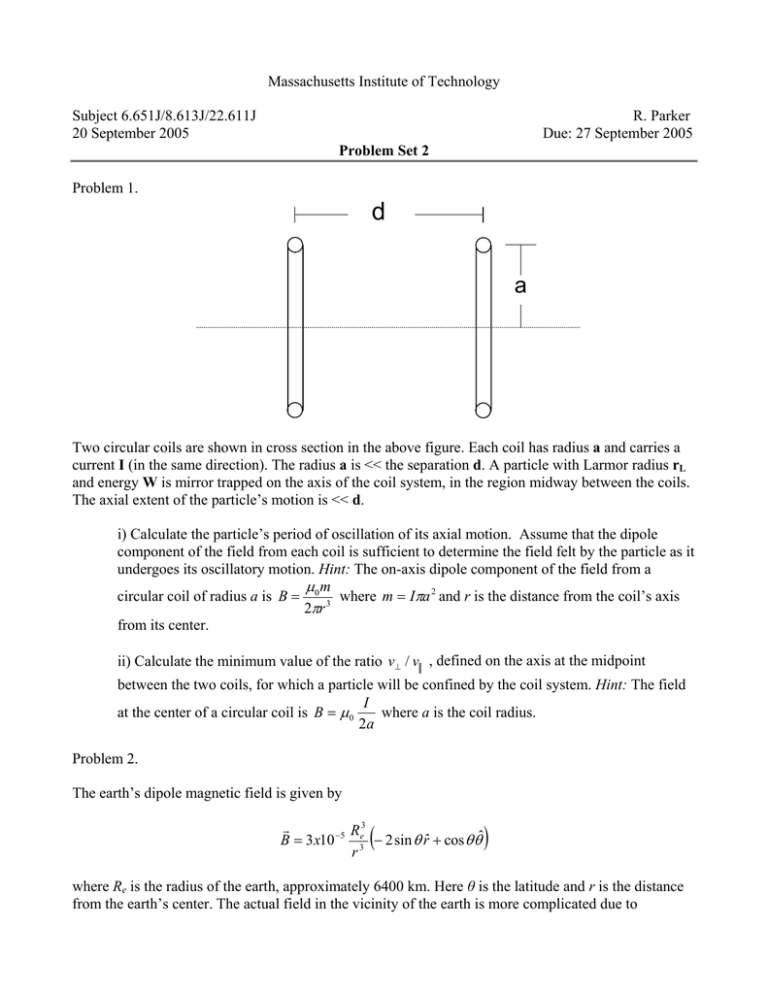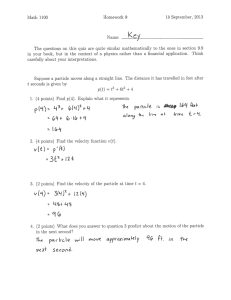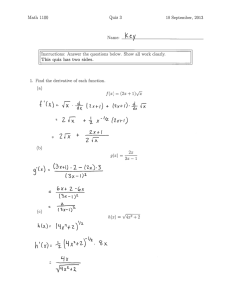Document 13608199
advertisement

Massachusetts Institute of Technology Subject 6.651J/8.613J/22.611J 20 September 2005 R. Parker Due: 27 September 2005 Problem Set 2 Problem 1. d a Two circular coils are shown in cross section in the above figure. Each coil has radius a and carries a current I (in the same direction). The radius a is << the separation d. A particle with Larmor radius rL and energy W is mirror trapped on the axis of the coil system, in the region midway between the coils. The axial extent of the particle’s motion is << d. i) Calculate the particle’s period of oscillation of its axial motion. Assume that the dipole component of the field from each coil is sufficient to determine the field felt by the particle as it undergoes its oscillatory motion. Hint: The on-axis dipole component of the field from a μm circular coil of radius a is B = 0 3 where m = Iπa 2 and r is the distance from the coil’s axis 2πr from its center. ii) Calculate the minimum value of the ratio v⊥ / v , defined on the axis at the midpoint between the two coils, for which a particle will be confined by the coil system. Hint: The field I at the center of a circular coil is B = μ 0 where a is the coil radius. 2a Problem 2. The earth’s dipole magnetic field is given by ( r R3 B = 3 x10 −5 3e − 2 sin θ rˆ + cos θ θˆ r ) where Re is the radius of the earth, approximately 6400 km. Here θ is the latitude and r is the distance from the earth’s center. The actual field in the vicinity of the earth is more complicated due to interaction with the interplanetary magnetic field and solar wind, but this complication will be ignored for the purpose of this problem. B dr = r . Carry out the rdθ Bθ solution to this ODE to find the equation of the field lines in the form r = r (θ ). i) The magnetic field lines are found by solving the differential equation ii) Let Be be the value of B on the equator (θ = 0) at some r. Determine B in terms of Be and θ, r where B is the magnitude of B that one would measure as one followed a field line from the equator. B B iii) A particle is injected into the earth’s field at some radius R0 at the equator. The particle has 2 1 energy W0, with W⊥ = W0 and W|| = W0 . Calculate the latitude θ ref at which the particle is 3 3 reflected. Assume θ ref is small enough that small argument expansions to lowest non-zero order in θ can be used for all trigonometric terms. iv) Using the particle’s drift velocity at the equator as characteristic of the particle’s drift velocity as it undergoes oscillation in latitude, estimate the time required for the particle to circle the earth. Evaluate numerically for a proton with W0 = 1 Mev injected at r =2Re. Is rL small enough for our derivation of the ∇B and curvature drifts to be valid? Problem 3. z y The figure illustrates a sheared magnetic field given by ⎧ B0 zˆ y < − a ⎫ ⎪ r ⎪⎪ y ⎪ B = ⎨ B0 zˆ − a < y < a ⎬ , ⎪ a ⎪ ⎪⎩− B0 zˆ y > a ⎪⎭ where ±a defines the sheared region and B0 is the constant field amplitude outside the sheared region. Such field configurations occur both in laboratory as well as in terrestrial and astrophysical plasmas. B i) Consider first a particle whose guiding center is located at x = 0, y = a/2 at t = 0. Describe its motion assuming rL << a. What constraint does this condition imply for the particle’s W⊥ ? ii) Consider now a particle whose position is located at x = 0, y = 0 with velocity vy = V, vx = 0, all at t=0. Derive the differential equations describing its motion. iii) By solving these equations, determine the maximum extent of the particle’s orbit in the ydirection. Assume that the parameters are such that the particle does not reach the region of uniform field. What condition assures that this will be a valid assumption?





